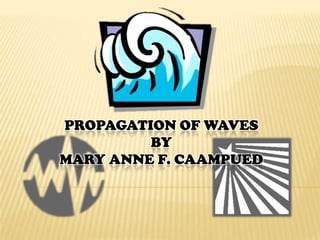
Propagation Of Waves
- 1. Propagation of WavesbyMary Anne F. Caampued
- 2. What does propagation means? To reproduce To cause to spread. What is a wave? A vibration or disturbance. SOUND & LIGHT are forms of energy that travel in waves.
- 4. Parts of a Wave Crest= High point of a wave. Trough=Low point of a wave. Amplitude (A)= Distance from the midpoint to the crest. Wavelength (λ)= The length of one complete wave.
- 5. Electromagnetic Spectrum Energy that is given off by electrons that moves in waves.
- 7. Type of medium The type of medium changes the way a wave moves. Mediums with close molecules travel quickly. This is why waves travel better in liquids and solids than in gases.
- 8. Radio wave Transmission There are two principal ways in which electromagnetic (radio) energy travels from a transmitting antenna to a receiving antenna. One way is by GROUND WAVES and the other is by SKY WAVES. Ground waves - are radio waves that travel near the surface of the Earth (surface and space waves). Sky waves - are radio waves that are reflected back to Earth from the ionosphere.
- 9. Ionosphere - extends upward from about 31.1 miles (50 km) to a height of about 250 miles (402 km). It contains four cloud-like layers of electrically charged ions, which enable radio waves to be propagated to great distances around the Earth. This is the most important region of the atmosphere for long distance point-to-point communications.
- 11. Ground (Surface) Wave The ground wave is actually composed of two separate component waves. These are known as the SURFACE WAVE and the SPACE WAVE. A surface wave travels along the surface of the Earth. A space wave travels over the surface.
- 12. Ground (Surface) Wave SURFACE WAVE—The surface wave reaches the receiving site by travelling along the surface of the ground. A surface wave can follow the contours of the Earth because of the process of diffraction. When a surface wave meets an object and the dimensions of the object do not exceed its wavelength, the wave tends to curve or bend around the object. The smaller the object, the more pronounced the diffractive action will be.
- 14. Surface Wave PROPAGATION As a surface wave passes over the ground, the wave induces a voltage in the Earth. The induced voltage takes energy away from the surface wave, thereby weakening, or attenuating, the wave as it moves away from the transmitting antenna. To reduce the attenuation, the amount of induced voltage must be reduced. This is done by using vertically polarized waves that minimize the extent to which the electric field of the wave
- 15. is in contact with the Earth. When a surface wave is horizontally polarized, the electric field of the wave is parallel with the surface of the Earth and, therefore, is constantly in contact with it. The wave is then completely attenuated within a short distance from the transmitting site. On the other hand, when the surface wave is vertically polarized, the electric field is vertical to the Earth and merely dips into and out of the Earth's surface. For this reason, vertical polarization is vastly superior to horizontal polarization for surface wave propagation
- 16. Surface Wave PROPAGATION The attenuation that a surface wave undergoes because of induced voltage also depends on the electrical properties of the terrain over which the wave travels. The best type of surface is one that has good electrical conductivity. The better the conductivity, the less the attenuation.
- 17. Exercises: Which ELECTROMAGNETIC WAVE has the most energy? The least?(4 pts.) Which ELECTROMAGNETIC WAVE has the longest wavelength? The shortest?(4 pts.) As frequency increases, what happens to energy?(2 pts.) As frequency increases, what happens to wavelength?(2 pts.) As the wavelength increases, what happens to the frequency of the waves?(2 pts.) Give at least 5 common names of waves.(5 pts.) What is a wave that travels along the surface of the Earth?(1 pt.)
- 18. THE END